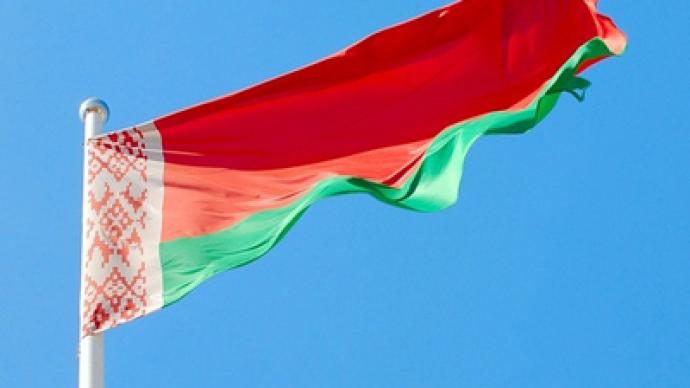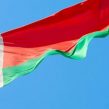
Tilting at Windmills: Why Do the West’s Belarus Policies Not Succeed?
Publication: Eurasia Daily Monitor Volume: 10 Issue: 93
By:

In Belarus, the second Sunday of May is celebrated as the Day of the National Emblem and Flag. “For a true citizen, there is nothing more sacred than the coat of arms and the flag of his or her country. Looking at them, each one of us feels inseparable from a single large family whose name is the Belarusian people,” President Alyaksandr Lukashenka told the nation on May 10 (https://news.tut.by/politics/347845.html).
The official symbols of independent Belarus are the slightly modified insignia of the Belarusian Soviet Socialist Republic. According to the Belarusian president, “our emblem and flag reflect […] a succession, a historical tradition, and an inextricable connection between the past, present and future of the country.” In Belarus, however, there is no consensus about the country’s past, present and future. The Belarusian opposition pledges allegiance to alternative national symbols. They also reflect a historical (albeit interrupted) succession dating back to the Grand Duchy of Lithuania (GDL). On May 6, several fans of the Belarusian national ice hockey team hoisted the alternative GDL-related flag during the Belarus-Slovenia match at the world championship in Sweden. Security guards attacked them and led them out, explaining that the flag contradicted safety measures. The International Ice Hockey Federation had decided to recognize the alternative flag of Belarus as “a political symbol” (https://sverigesradio.se/sida/artikel.aspx?programid=2103&artikel=5526099).
The alternative symbols of Belarus were in fact its only symbols from 1992 to 1995. At the referendum of May 1995, however, 75.1 percent of Belarusians voted for their replacement by new-old ones—that is, by the current flag and emblem symbolizing the link with the country’s more recent (compared with the GDL) past. According to a national survey published by the Warsaw-based Belarusian Analytical Workroom (Issue No. 7, March 2013), 67.5 percent of Belarusians consider the current red-and-green flag and coat of arms of the Republic of Belarus to be “their own,” and only 9.7 percent are committed to the alternative symbols.
“During its formative years, every nation-state strives to prove that its historical roots are long and traditions are lasting,” writes Valer Karbalevich of the Belarusian Service of Radio Liberty. “The deeper they go into history the better. Lukashenka, however, effectively jettisoned the entire Belarusian history and declared the Great Patriotic War [World War II] the start of nation-building. And the date of Minsk’s liberation from the Nazis became Belarus’s Independence Day. Usually, new countries emerging from the ruins of an empire strive to ideologically distance themselves from the empire’s core. It is no accident that during the breakup of the Soviet Union, nationalism in all Soviet republics [except Belarus] had an anti-Russian streak. In Belarus, however, everything was the other way round. No ideational schism occurred between independent Belarus and its Russian and Soviet legacies. All the social life of the country is imbued with nostalgia for the Soviet past—from the flag and coat of arms to street names and names assigned to subway stations, etc.” Karbalevich noted (https://www.svaboda.org/content/article/24982525.html).
Whether or not one likes Belarus’s birthmarks pointed out by Karbalevich, they are real and their meaning is no mystery. Most Belarusians have not yet cut the umbilical cord connecting their country with Mother Russia. Otherwise, 70 percent of Belarusians would not find it acceptable to merge their country into a single state with Russia if this would improve their wellbeing (see EDM, April 11). Moreover, a situation whereby almost 80 percent of Belarusians do not consider Russia to be a foreign country (see EDM, March 15) would also be unthinkable.
Because of this reality, certain generalizations about Russian society appear to be relevant to Belarus. This applies to the divide between the majority of the population craving state paternalism and the resourceful and self-sufficient minority. It also applies to the aforementioned argument about the national symbols of Belarus, which are related to diverging perceptions of the national interest. According to Dmitry Trenin, Director of the Moscow Carnegie Center, the absence of a national consensus about the country’s fundamental national interest implies a lack of a “political nation”—a common national identity that transcends all domestic political debates and factionalism. “In Russia,” writes Trenin, “a political nation is still absent, and this is a true foundation for the existence of a tsarist regime. If there is no political nation, the choice is straightforward: It is between chaos and the tsar. Despite its attendant minuses the latter alternative is better… Russian liberals would make a mistake,” adds Trenin, “if they expect too much [support] from the West. Ironically, that mistake would be even graver if those expectations are proven right… The attempts of the liberals to use the West as leverage to influence the Russian regime are either useless or harmful” (ej.ru/?a=note&id=12931).
The same argument can be extended to the exaggerated expectations of the Belarusian “democrats.” It is hardly a thoughtful strategy for the West to play along with their expectations. Yet, inviting only the Belarusian opposition—which is not at all represented in Belarus’s legislature—to the EURONEST, scheduled for May 28–29, in Brussels (racyja.eu/index.php?id=104&zoom=13865), is an example of just such a seemingly nonsensical policy. EURONEST is a “parliamentary forum to promote political association and further economic integration between the European Union and the Eastern European Partners [the Eastern Partnership (EaP) countries of Belarus, Ukraine, Moldova, Azerbaijan, Georgia and Armenia]” (https://www.euronest.europarl.europa.eu/euronest/cms/cache/offonce/home;jsessionid=B940840E55E13B4E019CAACA4CF45DA7). However, the other EaP countries, including Azerbaijan and Armenia, will be represented by their parliamentary deputies—not solely extra-parliamentary opposition members.
It seems as though EU foreign policy-makers are still under the impression that it is prudent to crave democracy in Belarus more ardently than Belarusians themselves do. As if to illustrate this point, an article recently appeared in the online opposition publication, Naviny.by, which asked, “What on earth can the opposition do in the absence of public demand for change?” (https://naviny.by/rubrics/politic/2013/05/14/ic_articles_112_181760/). If EU policy has indeed ossified in this way, it is unlikely to ever produce its intended results in Belarus. More likely, Brussels may have washed its hands of Belarus, and the respective acknowledgment is pending.




